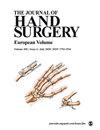非英国籍欧洲外科医生对桡尺关节远端不稳定性进行临床评估的可靠性
IF 1.6
2区 医学
Q2 ORTHOPEDICS
引用次数: 0
摘要
英国(UK)经验丰富的手外科医生对桡尺关节远端(DRUJ)不稳定性的临床评估结果显示并不可靠。本研究旨在测试英国以外的欧洲外科医生评估 DRUJ 稳定性的可靠性。34 名外科医生(22 名男性和 12 名女性)对四名参与者(八只手腕)进行了评估,他们的 DRUJ 分别为四只不稳定和四只稳定,并使用经过验证的夹具进行了测量,这些外科医生的平均年龄为 43 岁(29-61 岁不等)。临床评估 DRUJ 不稳定性的敏感性为 32%,特异性为 88%,阳性预测值为 72%,阴性预测值为 56%。在测试前一天参加过 1 小时 DRUJ 稳定性临床评估研讨会的外科医生与未参加者相比,在评估 DRUJ 不稳定性方面并不更可靠。这进一步强调了在评估DRUJ时需要更好的培训和反馈,以及在科学研究报告中对DRUJ不稳定性进行客观评估的必要性:V本文章由计算机程序翻译,如有差异,请以英文原文为准。
The reliability of clinical assessment of distal radioulnar joint instability among non-United Kingdom European surgeons
Clinical assessment of distal radioulnar joint (DRUJ) instability has been shown to be unreliable among experienced hand surgeons in the United Kingdom (UK). The aim of this study was to test the reliability of assessing DRUJ stability in European surgeons outside the UK. Four participants (eight wrists) with four unstable and four stable DRUJs as measured with a proven jig were assessed by 34 surgeons (22 men and 12 women) with a mean age of 43 years (range 29–61). Clinical assessment of DRUJ instability had a sensitivity of 32%, specificity of 88%, a positive predictive value of 72% and a negative predictive value of 56%. Surgeons who had attended a 1-hour workshop on clinical assessment of DRUJ stability the day before the testing were no more reliable at assessing DRUJ instability when compared with those who did not. This further highlights the need for better training with feedback when assessing the DRUJ and the need for objective assessment of DRUJ instability when reported in scientific studies.Level of evidence: V
求助全文
通过发布文献求助,成功后即可免费获取论文全文。
去求助
来源期刊
CiteScore
3.10
自引率
16.70%
发文量
190
审稿时长
4-8 weeks
期刊介绍:
The Journal of Hand Surgery (European Volume) is essential reading for everyone involved in restoring the function to the hand and upper limb. Dedicated to the needs of hand, plastic, reconstructive and orthopaedic surgeons, it publishes the best selection of current papers on hand surgery.
The journal regularly highlights key developments in a range of original, authoritative and highly informative articles written by distinguished experts from around the world. Rapid coverage of the latest research, techniques, trends and ideas to make sure you stay up-to-date.
Subjects covered include:
joint replacement
fracture and joint injuries
microvascular surgery
congenital hand problems
You will also find editorials, book reviews, conference dates, case studies, detailed coverage of new techniques and full-length reviews articles.

 求助内容:
求助内容: 应助结果提醒方式:
应助结果提醒方式:


